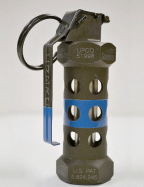Reasons for instability
Composition
Presence of nitrogen

Explosives that are nitrogen-based are incredibly volatile due to the stability of nitrogen in its diatomic state, N2. [5] [6] Most organic explosives are explosive because they contain nitrogen. They are defined as nitro compounds.
Nitro compounds are explosive because although the diatomic form of nitrogen is very stable—that is, the triple bond that holds N2 together is very strong, and therefore has a great deal of bond energy—the nitro compounds themselves are unstable, as the bonds between nitrogen atoms and other atoms in nitro compounds are weak by comparison. Therefore, little energy is required to overcome these weak bonds, but a great deal of energy is released in the exothermic process in which the strong triple bonds in N2 are formed. The rapidity of the reaction, due to the weakness of the bonds in nitro compounds, and the high quantity of overall energy released, due to the much higher strength of the triple bonds, produce the explosive qualities of these compounds.
Oxidizer and fuel
Some contact explosives contain an oxidizer and a fuel in their composition. [6] Chemicals like gasoline, a fuel, burn instead of explode because they must come into contact with oxygen in the combustion reaction. However, if the compound already contains both the oxidant and fuel, it produces a much faster and violent reaction.
Bonds and structure

The structures and bonds that make up a contact explosive contribute to its instability. Covalent compounds that have a large unequal sharing of electrons have the capability to fall apart very easily and explosively. Nitrogen triiodide, for example, features three iodine atoms weakly covalently bound to the far more electronegative nitrogen atom. The valence shell electrons of iodine, located one orbital above that of nitrogen, strongly preferentially lean towards the nitrogen atom, making the bond weak, thus leading to a low activation energy for dissociation. The bond is thus easily broken with little input energy, in turn providing energy for nearby molecules to dissociate, leading to an explosive chain reaction due to the large amount of excess energy released.
The shape of the contact explosive molecule plays a role in its instability as well. Using nitrogen triiodide as an example again, its pyramidal shape forces the three iodine atoms to be much closer together than if they were in a planar configuration, further weakening stability through steric hinderance.
| Compound | Reason for instability |
|---|---|
| Acetone peroxide | Composition allows for initiation reaction |
| Chlorine azide | Nitrogen |
| Copper(II) azide | Nitrogen |
| Fulminates | Instability of fulminate ion |
| Lead(II) azide | Nitrogen |
| Nitrogen triiodide | Unstable intramolecular bonds |
| Nitroglycerin | Nitrogen, Oxidizer and fuel |
| Picric acid (dry) | Nitrogen |
| Tetrasulfur tetranitride | Nitrogen, Unstable intramolecular bonds |
| Flash Powder | Oxidizer and metallic fuel |
| Silver nitride | Unstable intramolecular bonds |

